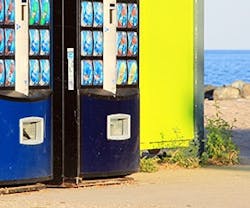Bottled water, juice, pop, iced tea, energy drinks – do you know how much you’re paying each year to keep these beverages cold?
Between illuminating products within and compressor cycles needed for refrigeration, don’t overlook the impact of one vending machine on your utility bill.
“People forget that these machines run 24/7, even when there’s no one around. Vending machines use 7-14 kWh a day, with an average cost of $300-350 to operate annually,” explains Mark Dunne, an energy efficiency project manager for Van Meter Inc., an electrical solutions provider. “Multiply that by several machines and that’s a fair amount of money you’re spending to simply cool beverages in your facility.”
By using a few simple and low-cost solutions, you can easily curb your machine’s impact on the environment. Try any of these strategies when selecting a vendor, requesting a machine upgrade, or modifying your existing unit:
- Choose an ENERGY STAR-Rated Machine: According to ENERGY STAR, a qualified vending machine consumes around 40% less energy than a non-rated unit. Manufacturers achieve savings by using more efficient compressors, fan motors, and lighting components. Contact your vending operator and request to switch – you should be able to make the change without incurring any fees.
- Select Sustainable Refrigerants: PepsiCo and the Coca-Cola Company have joined a global initiative called Refrigerants Naturally! Program participants strive to eliminate hydrofluorocarbon (HFC), a known greenhouse gas, in refrigerant and insulation components and use naturally produced alternatives instead. If your machines are older, call your company for a newer model or converter option.
- Use Better Lighting: According to the EPA, 150-180 watts are used to continuously power the lights and ballasts in a vending machine, around $100 every year. Look for T8 replacement lamps and electronic ballasts to limit energy use. Timers can also be added that will cut the machine’s lights at night and on weekends when the impact on sales would be minimal.
- Turn Off the Lights: Simply disconnecting the lights can save up to 35% with no other modifications. Make sure to communicate to occupants the benefits of de-lamping your machines and include signage that indicates the machine is still operational.
Controls for Your Machine
To put a permanent dent in a vending machine’s energy consumption, use an external control. These units feature an occupancy sensor that switches the machine to unoccupied mode after 15 minutes of room inactivity, reducing the number of compressor cycles required.
How Much Can You Save?
A vending machine uses anywhere from 7-14 kWh daily to cool beverages, which can average $250-500 a year to run. Slash your operating expenses with these low-budget options.
| OPTION | INSTALLATION COST | ENERGY REDUCED | SAVINGS (ANNUAL) |
| delamping | $0 | 35% | $127 |
| energy star rating | $0 | 40% | $146 |
| Compressor control | $100-150 | 30% | $109 |
Calculated using one machine using 10 kWh daily / 3,650 kWh annually and a $0.10/kWh electricity rate.
“It takes a fair number of compressor cycles to keep the temperature exact,” says Cary Sagady, SVP of network solutions and product management for USA Technologies, which manufactures a vending machine control product. “If you allow the product temperature to rise by 2-5 degrees F., you can save 30% of the energy required to keep it cool. It’s much like adjusting your home thermostat in the winter or summer – a couple of degrees makes a difference.”
The 30% savings will lower a machine’s annual operating costs by $100-150. If you have 10 machines, that’s $1,000 a year that will stay in your pocket.
Because bottled beverages have a relatively stable shelf life, the fluctuating temperatures won’t impact the taste or safety of the product.
“The controls still keep the product cold – they’re not shutting off the machine and allowing everything to come up to room temperature,” assures Dunne.
Controls range from $100-200, providing an average payback of one year. Some utilities offer a turnkey program that installs these devices at no cost while others provide rebates for 50-75% of the unit cost.
Controls are best for traditional beverage machines, Sagady stresses. Those selling products that could spoil shouldn’t be adjusted, like dairy, freezer, or deli.
To maximize savings, try combining several strategies to lower energy use even further. No matter which option you deploy, your savings will be refreshing.
Jennie Morton [email protected] is associate editor of BUILDINGS.
About the Author
Jennie Morton
Jennie Morton is a freelance writer specializing in commercial architecture, building engineering, and sustainable design.
